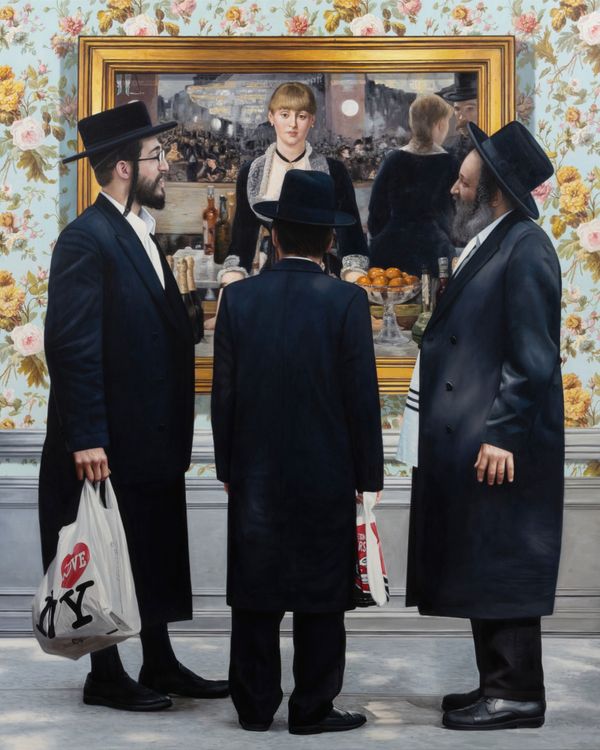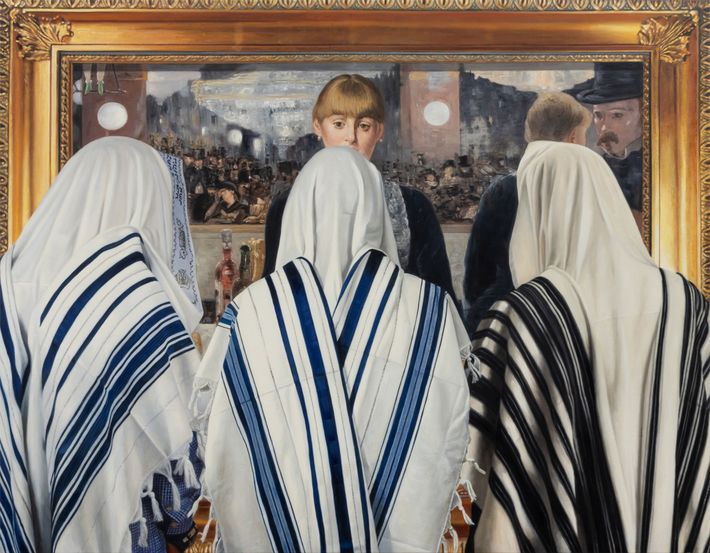
The title of Marc Dennis’s new show, Three Jews Walk Into a Bar, at A Hug From the Art World gallery sounds like the setup for a joke. And it is a little bit. Each painting is a meticulous, photorealist image of three Hasidic Jews standing in front of Edouard Manet’s 1882 masterpiece A Bar at the Folies-Bergere. They crowd out the picture, are in the way. No one else is around, emphasizing their clique-ish isolation. They gaze at the painting intently, studying its finer details the way they study their Torah.
The point, of course, is that you almost never see Hasids behaving this way in public. Dennis’s show is a joke all right. But is it funny?
The Manet exists in a separate universe — the universe of the secular, the arts, the modern. It is one of the treasures of the Courtauld in London and sits somewhere near the pinnacle of 19th-century French painting. The painting’s subject, a barmaid who in real life was named Suzon, stands at the center looking blankly into space. In the mirror behind her, we can see the circus going on around her. She is enigmatic and gorgeous. She now also presides over these recognizably Jewish figures with their fur hats and side curls and heavy black shoes, as if from the altar of an alien religion.
Dennis, a Jew who can trace his roots to the Biblical Aaron and Moses, appears to be commenting on the Hasidic penchant for insularity. They dress differently from everyone else. They stick to themselves, separate the sexes, don’t go into the office with the rest of us. One of Dennis’s paintings shows them carrying plastic shopping bags, and I thought, Yes, they always seem to have those bags. I had to catch myself: Where did this “they” come from? I’m Jewish too, after all.
Thus, when he depicts them not only pointing and peering at this famous painting but also discussing it with their companions as if they were sophisticated museumgoers who had minored in the canon of Western painting at their liberal-arts college, the joke seems to be rather on the nose.
But Dennis introduces complications. There is one painting in which the three Hasids are wearing form-fitting trench coats instead of the usual somber black coat. Another sees them waving their black fedoras as if they were in a chorus line. The weirdest might be one in which the three are fully cloaked in prayer shawls, looking far more ancient than the 19th-century woman in Manet’s painting — as if they were looking not at the past but the future. The relationship between the viewer and the museum piece gets all scrambled when the viewer has stood still, so to speak.
At the same time, who are we to feel so superior? If you’ve been to any museum in New York lately, you’ll know that the people in the crowd, mostly tourists or people who were dragged there, for the most part don’t go right up to the painting with their companions to point, ponder, and reflect on what they’re seeing as the Hasids in Dennis’s paintings do. Instead, they brandish their smartphones and snap photos and selfies, post them on the internet, and move on to the next masterpiece. The whole experience seems a blur. I’m not sure I like Dennis’s paintings, but I haven’t been able to stop thinking about them. Perhaps, in the end, the joke is on us.


